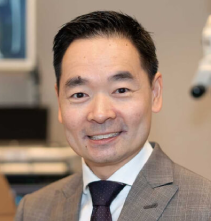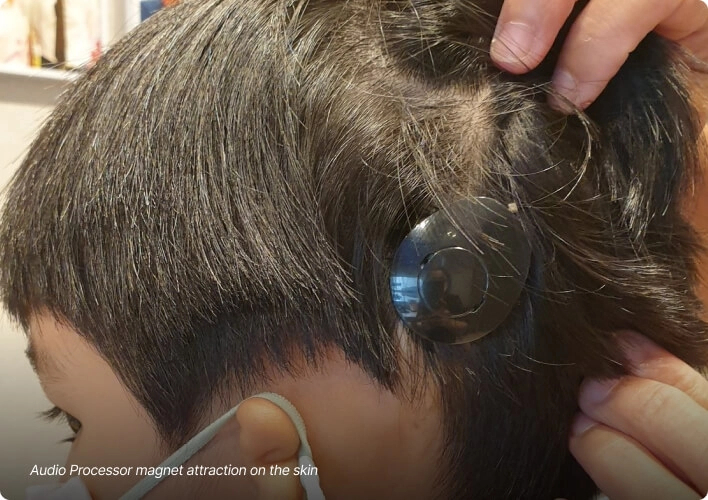- +65 6738 1616
- +65 8123 1214
- info@drbarrietan.com
Home > ENT Services > Bone Conduction Implants

Bone conduction implants are another different class of surgical hearing implants. These implants work by transmitting sound signals as vibrations through the skull bone to reach the cochlea (inner ear). The sound signals bypass the usual acoustic pathway where sound waves are carried in the air through the ear canal and vibrate the eardrum and middle ear bones before eventually stimulating the inner ear.


They are used to restore hearing to patients with 2 main types of hearing loss.
The first group is those who have conductive hearing loss. In this type of hearing loss, there is a problem either in the outer ear or the middle ear that impedes the transmission of the sound wave vibrations and prevents them from reaching the inner ear well.
Since bone conduction implants send the signals directly to the inner ear, they will bypass all these problems. These would include conditions like microtia and atresia of the ear, previous radical mastoidectomy cavities, and ossicular chain abnormalities.
The second group of patients which this helps is those who have single-sided deafness. In these individuals, they are deaf in one ear but the other ear still hears well. These patients often struggle to hear when sounds are coming from the side where the ear is deaf. They often have to turn their heads towards the deafened side so that they can hear with their good ear.
Bone conduction implants help to route the sound signals from the deafened side over to the good ear. These implants vibrate the skull and these skull vibrations transmit to both the deafened inner ear as well as to the inner ear on the other side which is the good ear. This allows the good ear to perceive sounds received from the side where the ear is deaf. This is called pseudo-binaural hearing and it allows these patients to be able to hear sounds that otherwise would have been missed since they would have come into the deaf ear.

Only 1 device is worn as compared to the other technology that routes signals to the good ear, which is the Contralateral Routing of Signal (CROS) Hearing Aids. In the CROS hearing aid system, patients have to wear 2 hearing aids – one on the deaf ear to collect the sound, and another on the good ear to receive the wireless transmission of signals and present the sound into the good ear.
There are several different bone conduction implant models and brands. There are broadly 2 main types. The first type is where the external speech audio processor actively vibrates and transmits the vibrations to a screw that is implanted into the skull. These include the Bone Anchored Hearing Aids by Cochlear Ltd and the Ponto System by Oticon Medical. The second type is where the external speech audio processor does not vibrate but merely transmits the signals to the internal device that is implanted into the skull. The internal device is the one that actively vibrates the skull. This is known as Direct Drive Bone Conduction. An example of this would be the Bonebridge Implant by MedEl.

Nowadays, many patients are opting for the Transcutaneous Bone Conduction Implant systems where there is no exposed screw that is visible coming out from the skull. Instead, the screws and magnet of the internal device are entirely hidden under the skin. Users wear the external speech audio processor that magnetically couples with the internal magnet through an intact skin. This is cosmetically more appealing than seeing an exposed screw. It is also generally safer as it has less wound complications and skin problems. There are also fewer complications with skull fractures from inadvertent falls onto an exposed screw.
Bone conduction implantation surgery is a generally safe surgical procedure and it can be performed in children as young as 4 years of age. There is no upper age limit and very elderly patients can undergo this surgery as well. Operative time usually takes about an hour under general anaesthesia. After surgery, the head is bandaged with a compression bandage for 1 night and this is removed the next day, and the patient discharges. 1 week later, the sutures are removed. The device is then switched on and the patient starts wearing the device at 3 weeks post-surgery.
Senior Consultant ENT Specialist
MBBS (Singapore), MMed (ENT) (Singapore)
MRCS (Edinburgh, UK), FAMS (Otolaryngology)
Dr Barrie Tan is a dedicated ENT specialist with over 20 years of experience and a keen focus on hearing loss and cochlear implants, among others. Prior to setting up his own practice, Dr Tan was the Head of the ENT Department at the Singapore General Hospital (SGH) – the largest ENT department in Singapore – as well as the Director of the Centre for Hearing and Ear Implants at SGH.
Dr Tan was a President’s Scholar and completed his subspeciality Fellowship in Otology, Hearing Implant, Neurotology and Skull Base Surgery at the Ear Science Institute in Australia. Today, Dr Tan remains actively involved in the ENT fraternity, holding several leadership positions and being engaged in the nurturing of the next generation of ENT surgeons. He has organized numerous ENT conferences and continues to devote his time towards meaningful volunteer work and medical missions.
